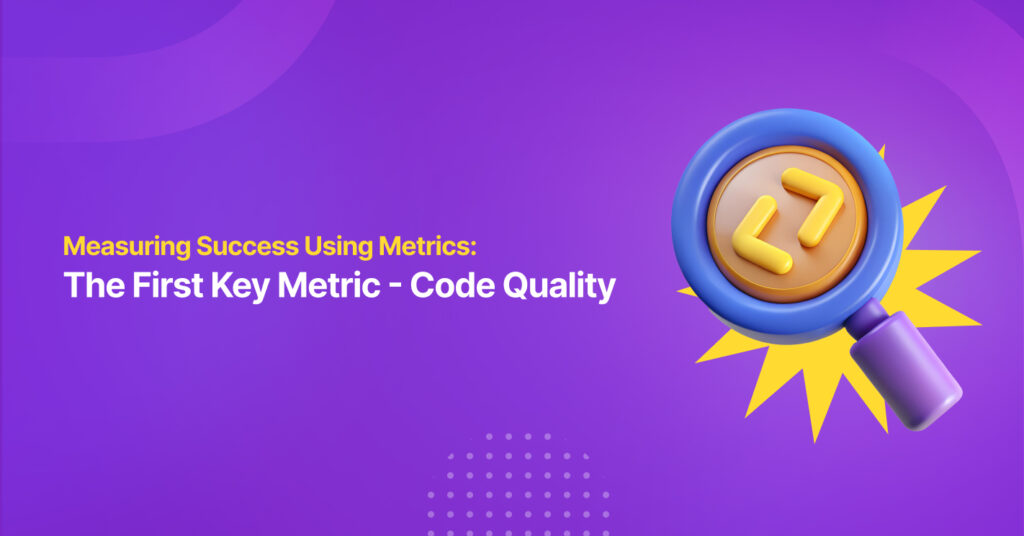This article is part 2 of our series on measuring success using metrics to assess the performance of augmented software teams. If you haven’t read part 1 of the series yet, we encourage you to check it out for an overview of the key metrics that are essential for managing software development projects, especially in outsourced settings.
When it comes to software development, particularly in outsourcing scenarios, code quality is like the backbone of your project. Just as a solid foundation is crucial for building a strong house, good code quality ensures your software is reliable, easy to maintain, and performs well. In this article, we’ll dive deeper into the specifics of code quality and explore the key metrics that help in evaluating and improving it.
Introduction
Code quality refers to how well your code works and how easy it is to read, maintain, and expand. It’s not just about making sure your code runs correctly but also about ensuring it’s clean and understandable for anyone who might work on it in the future. High-quality code helps prevent bugs, improves performance, and makes the software easier to update.
In this article, we will explore several key metrics that help measure and improve code quality: Bug Rate, Technical Debt, Code Coverage, Static Code Analysis, Coding Standards Compliance, Code Complexity, Code Review Coverage, and Code Churn.
Detailed Metrics Analysis
Let’s dive into each of these metrics to understand how they contribute to code quality and how you can monitor and optimize them in your projects.
1. Bug Rate
Bug Rate is a measure of how many bugs are found in your code over time. Bugs are errors or flaws in the software that cause it to behave unexpectedly. A high bug rate indicates poor code quality, as it means your code has many issues that need fixing. Measuring defect rates in software allows developers to quantify the quality and stability of the product over time. (McConnell, 2004, Code Complete)
How to Measure Bug Rate:
- Track the number of bugs reported per unit of code, such as lines of code or function points.
- Monitor how this number changes over time to see if your code quality is improving or worsening.
Practical Advice:
- Regularly review and update your bug tracking system.
- Focus on fixing bugs as soon as they are discovered to prevent them from accumulating.
2. Technical Debt
Technical debt is a concept in software development that reflects the implied cost of additional rework caused by choosing an easy solution now instead of using a better approach that would take longer (Brown & Cai, 2010). Technical Debt is like borrowing time by taking shortcuts in your code. It speeds up development now but can lead to more work and problems later. It’s like choosing a quick, easy fix instead of a long-term solution. Over time, technical debt can slow down development and make the code harder to maintain.
How to Measure Technical Debt:
- Calculate the time or effort needed to fix the shortcuts or poor-quality code.
- Use tools like SonarQube to analyze your code and provide estimates of technical debt.
Practical Advice:
- Regularly refactor your code to pay down technical debt.
- Avoid quick fixes that lead to more problems in the future.
3. Code Coverage
Code Coverage measures the extent to which the code has been exercised during testing, not just by unit tests but across all testing practices, including integration and end-to-end tests. This metric is critical for understanding how thoroughly the codebase is tested. It’s important to note that higher code coverage does not necessarily equate to fewer bugs. High coverage indicates more of the codebase has been tested, but it does not guarantee that all edge cases or logical errors have been caught. High test coverage is a valuable indicator of a well-tested codebase, but it is not a definitive guarantee of defect-free code (Fowler, 2020, Test Coverage).
How to Measure Code Coverage:
- Use testing tools to check what percentage of your code is covered by tests. Tools like JUnit or pytest can help with this.
- Aim for high coverage but remember that 100% coverage doesn’t guarantee bug-free code.
- A good target for code coverage is between 70% and 80%, which strikes a balance between thorough testing and reasonable effort (Kent, 2016, The Pragmatic Programmer).
Practical Advice:
- Write tests for new code as you develop it.
- Regularly review and update your tests to cover more parts of your code.
4. Static Code Analysis
Static Code Analysis uses automated tools to check code for potential issues without executing it. Static analysis tools can provide immediate feedback on potential bugs, code smells[MP1] , and security vulnerabilities (Johnson & Sienicki, 2012, Static Code Analysis).
How to Perform Static Code Analysis:
- Use tools like ESLint for JavaScript or Pylint for Python to analyze your code without running it.
- Regularly run these tools as part of the development workflow to catch issues early.
Practical Advice:
- Integrate static code analysis into your development workflow to catch issues before they reach production.
- Keep analysis tools updated with the latest rules and guidelines.
5. Coding Standards Compliance
Coding Standards Compliance ensures that your code follows predefined guidelines for style, naming conventions, and structure. This practice improves code readability and maintainability. Adhering to coding standards not only improves readability but also enhances collaboration among team members (Green, 2015, Clean Code).
How to Ensure Coding Standards Compliance:
- Use linters and formatters like Prettier or Black to enforce coding standards automatically.
- Conduct regular code reviews to ensure compliance with established standards.
Practical Advice:
- Define and document coding standards for your team.
- Encourage adherence to these standards to maintain consistency across the codebase. This is especially important where your development team is a blend of local and geographically disparate coders. It is important that your entire team understand and follow the same standards throughout your project.
6. Code Complexity
Code Complexity, often measured by Cyclomatic Complexity, refers to the complexity of the code in terms of the number of linearly independent paths through the code. Higher complexity makes code harder to understand, test, and maintain. Cyclomatic complexity is a useful measure of a program’s logical complexity, which directly impacts its testability and maintainability (McCabe, 1976, A Complexity Measure).
How to Measure Code Complexity:
- Use tools like SonarQube or Code Climate to calculate the complexity of your code.
- Focus on reducing complexity by breaking down large functions and simplifying logic.
Practical Advice:
- Aim for lower complexity to improve code maintainability.
- Regularly refactor complex code to make it simpler and easier to work with.
7. Code Review Coverage
Code Review Coverage measures the percentage of code changes reviewed by peers before being integrated into the main code base. Code reviews help catch mistakes, improve code quality, and facilitate knowledge sharing among team members. Code reviews are an essential practice for ensuring code quality and promoting knowledge sharing within a team (Kononenko, Baysal, & Holmes, 2015).
How to Measure Code Review Coverage:
- Track the percentage of code changes that are reviewed by others.
- Use tools like GitHub or GitLab to facilitate and track code reviews.
Practical Advice:
- Make code reviews a standard part of your development process.
- Foster a culture of constructive feedback to improve code quality and team knowledge.
8. Code Churn
Code Churn measures how often your code changes over time. High code churn can indicate instability or frequent modifications, which might suggest underlying issues with the codebase or requirements. Relative code churn measures have been found to be significant predictors of defect density in software systems (Nagappan & Ball, 2005).
How to Measure Code Churn:
- Track the number of lines of code added, modified, or deleted over a given period.
- Use version control systems like Git to track and analyse the changes in your codebase.
Practical Advice:
- Investigate high churn areas to understand why they are changing frequently.
- Focus on stabilizing these areas to reduce unnecessary changes and improve code stability.
Conclusion
Maintaining high code quality is essential for the success of software projects, especially in outsourcing relationships. By focusing on key metrics such as Bug Rate, Technical Debt, Code Coverage, Static Code Analysis, Coding Standards Compliance, Code Complexity, Code Review Coverage, and Code Churn, you can build stronger, more reliable software.
Measuring these metrics helps identify areas for improvement, foster better development practices, and ensure that software remains robust and adaptable, making future development smoother and more predictable.
In part 3 of our series on measuring success using metrics, we will delve into Productivity metrics and explore how they can further enhance the management and performance of software development teams. Stay tuned!
Ready to improve your code quality? Contact Mitrais by filling out the form below to learn more about integrating these metrics into your projects and ensuring software success.
References
Brown, N., & Cai, Y. (2010). Managing Technical Debt in Software Development. In Proceedings of the FSE/SDP workshop on Future of Software Engineering Research (pp. 47-50). https://doi.org/10.1145/1882362.1882373
Fowler, M. (2020). Test Coverage. Martin Fowler’s Blog. Retrieved from https://martinfowler.com/bliki/TestCoverage.html
Green, D. (2015). Clean Code: A Handbook of Agile Software Craftsmanship (pp. 45-49). Prentice Hall.
Johnson, P. M., & Sienicki, R. (2012). Static Code Analysis. IEEE Software, 29(6), 10-12. https://ieeexplore.ieee.org/document/6340651
Kent, B. (2016). The Pragmatic Programmer: Your Journey To Mastery (pp. 115-118). Addison-Wesley Professional.
Kononenko, O., Baysal, O., & Holmes, R. (2015). Code Review Quality: How Developers See It. In Proceedings of the 37th International Conference on Software Engineering (pp. 102-104). https://dl.acm.org/doi/10.1109/ICSE.2015.178
McCabe, T. J. (1976). A Complexity Measure. IEEE Transactions on Software Engineering, SE-2(4), 308-320. https://ieeexplore.ieee.org/document/1702388
McConnell, S. (2004). Code Complete: A Practical Handbook of Software Construction (2nd ed., pp. 69-72). Microsoft Press.
Nagappan, N., & Ball, T. (2005). Use of Relative Code Churn Measures to Predict System Defect Density. In Proceedings of the 27th International Conference on Software Engineering (pp. 284-288). https://dl.acm.org/doi/10.1145/1062455.1062514






